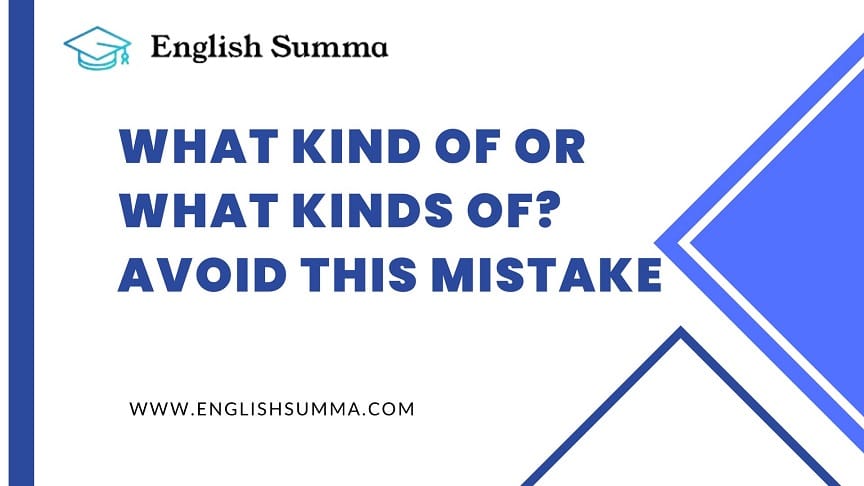Native English speakers often wonder if they should use “what kind of” or “what kinds of” in a sentence. The basic grammar rule is that “kind of” is used with singular, uncountable nouns, while “kinds of” is used with plural, countable nouns.
However, in casual spoken English, the phrases are sometimes used interchangeably. This article explains the technical differences and gives examples of proper usage in both formal written English and informal speech.
Key Takeaways:
- In proper English, “kind of” is used with singular nouns and “kinds of” with plural nouns
- In casual conversation, native speakers often use these phrases interchangeably
- Formal vs informal language depends on context
- Regional dialects also play a role
- Understanding the flexible nature of English helps non-native speakers communicate better
Grammar: Countable vs Uncountable Nouns
The choice between “kind of” and “kinds of” depends on whether the noun is countable (referring to something that can be quantified) or uncountable (referring to something that cannot be individually counted). For example:
- Countable nouns: chairs, books, cats
- Uncountable nouns: information, furniture, advice
Countable nouns can be made plural by adding “s”. We can have one chair or five chairs. So with countable nouns, “kinds of” is correct:
“What kinds of books do you enjoy reading?”
However, uncountable nouns remain singular. We cannot have “one information” or “five informations”. So with uncountable nouns, “kind of” is correct:
“What kind of information is included in the report?”
This is the standard grammar rule taught in English classes and used in formal writing. But in verbal everyday speech, people often overlook this distinction.
Learn which form is correct, Of Course or Ofcourse
Spoken vs Written English
In casual spoken English, native speakers frequently use “kind of” and “kinds of” interchangeably, even when it goes against textbook grammar rules.
For example, someone might say:
“What kinds of food do they serve at that restaurant?”
Instead of:
“What kind of food do they serve at that restaurant?”
Or:
“What kind of books do you like to read?”
Instead of:
“What kinds of books do you like to read?”
This shows that in informal conversational English, the phrases “kind of” and “kinds of” are often used loosely, without paying attention to countable vs uncountable distinctions.
However, in formal written English, especially in published books or articles, standard grammar rules are strictly followed. Writers use “kind of” with singular nouns and “kinds of” with plural nouns.
Is it Ninth or Nineth? Avoid this common mistake!
Formal vs Informal Language
Whether we use standard grammar or casual speech depends on the situation and context.
In formal academic writing or professional publications:
➡️ Use proper grammar – “kind of” or “kinds of”
In friendly conversations:
➡️ Use looser grammar – interchangeable
Text messages, emails, social posts to friends:
➡️ Often use informal language
The same principle applies to many aspects of English language, such as using full sentences vs sentence fragments, proper capitalization and punctuation, etc. The language formality exists on a sliding scale.
Is it Trainning or Training – Avoid This Critical Mistake!
Regional Differences
Another factor that affects the interchangeable use of “kind of” and “kinds of” is regional dialects. For example, these phrases may follow slightly different rules in British English compared to American English or Australian English. Certain informal usage patterns are more common in some areas than others.
Over time, if informal speech leads language change, then the once “incorrect” uses can become accepted. Language experts continue debating these evolving issues.
Don’t get confused and learn what’s correct: Puting or putting?
Examples and Exercises for Mastery
Gaining confidence in using “kind of” vs “kinds of” correctly comes with practice. Try these examples and exercises:
Example #1
Circle the right phrase in the sentences below:
“What (kind of, kinds of) desserts do you enjoy?”
Desserts is a plural/countable noun, so “kinds of” is correct.
“What (kind of, kinds of) information does the book contain?”
Information is a singular/uncountable noun, so “kind of” is correct.
Example #2
Fill in the blanks with either “kind of” or “kinds of”:
“My favorite ____ music is jazz and hip hop.”
(kind of)
“What ____ books inspire you the most?”
(kinds of)
“I prefer all ____ Italian food, especially pasta.”
(kind of)
Exercise
Construct five original example sentences using “kind of” and “kinds of” properly with various singular and plural nouns.
Read more about the correct spelling of Shiney or Shiny
Answer Key
Here are some sentence examples for practice:
“This restaurant serves all kinds of tapas with unique flavors.”
“What kind of transportation is best for traveling across Europe?”
“I enjoy all kinds of sports, especially basketball and tennis.”
“What kind of tea do you prefer – herbal or black?”
“There are two main kinds of grammar rules in English: syntax and morphology.”
Practicing these distinctions in different sentence formations will help solidify mastery of when to use “kind of” vs “kinds of” correctly in formal English language. Internalizing the grammar rules while also observing informal usage takes learning to the next level.
Conclusion
Paying attention to the context, audience, and purpose helps determine the right level of formality. While grammar rules provide an anchor, language also evolves through usage over time. By observing actual practice, English learners can better grasp which forms of expression work best in any given situation.

